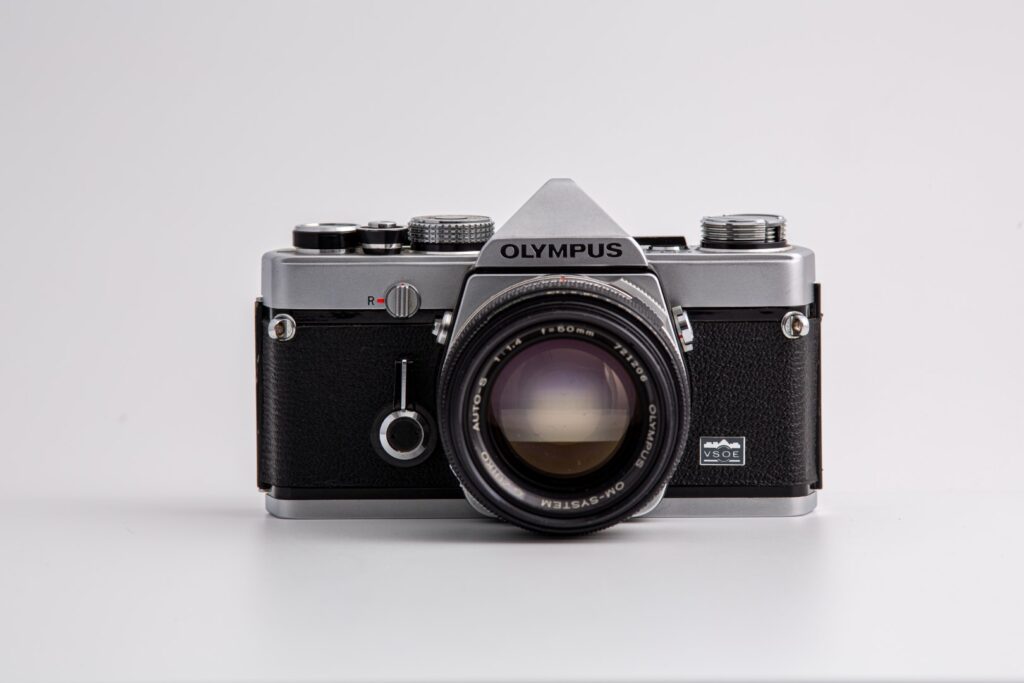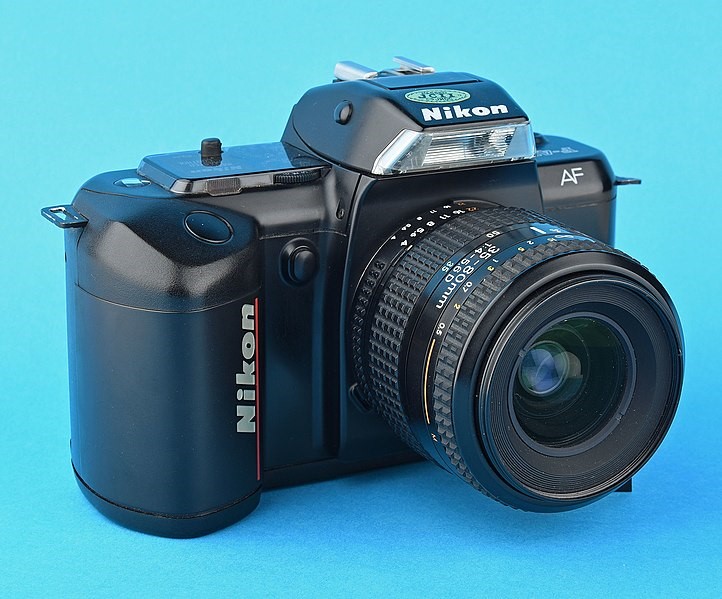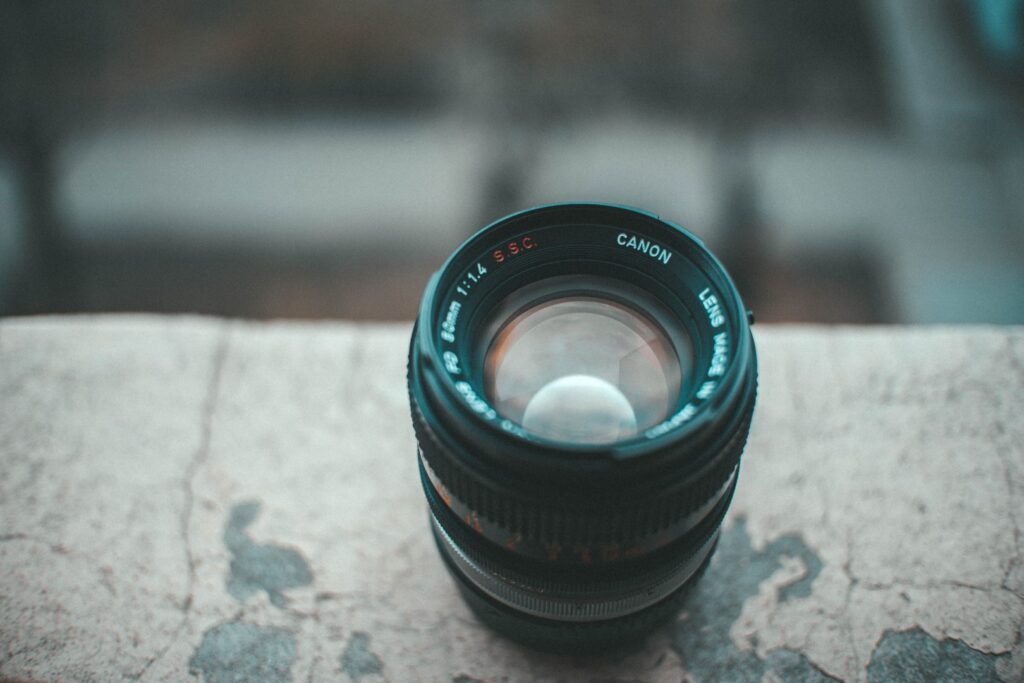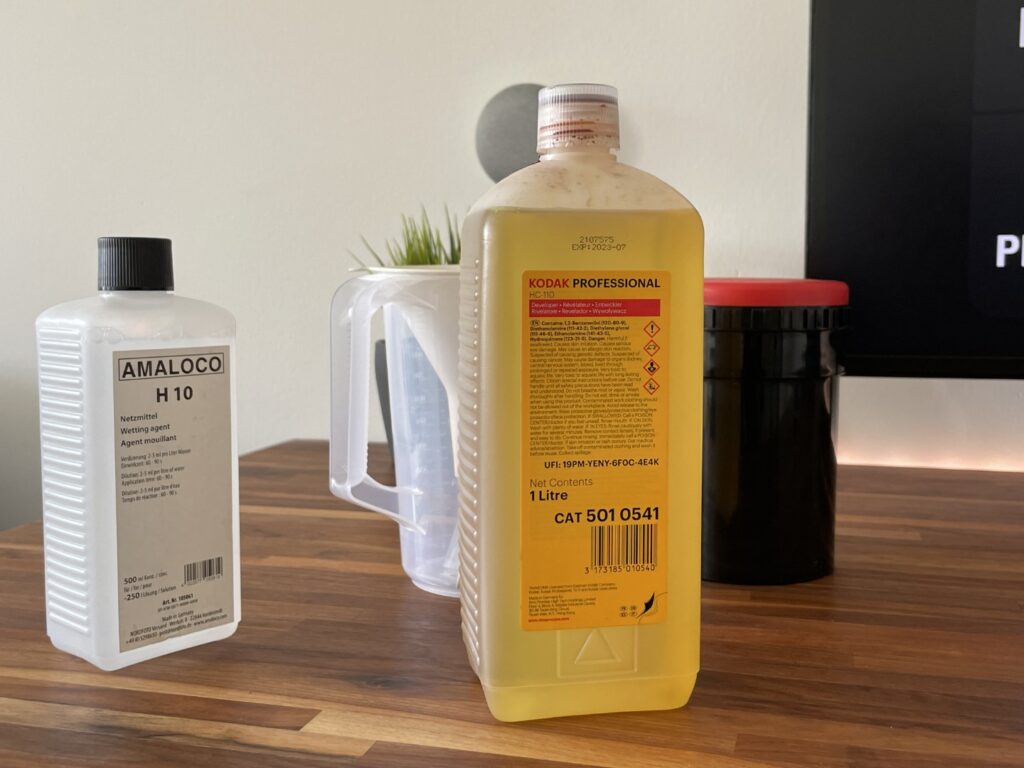Embarking on the journey of film photography is a thrilling voyage of discovery, presenting an artistic depth that captivates even in our digital age. The Olympus OM-1, introduced in the 1970s, brought about a significant change in the photography world with its professional-grade capabilities packed into a compact design. Due to its lightweight yet robust build, intuitive layout, and superior mechanical reliability, the Olympus OM-1 rapidly gained popularity, and even decades after its release, it is highly respected within the photography community. Its enduring success is a testament to its timeless design and the consistent quality of results it delivers.
A crucial aspect of unlocking the Olympus OM-1’s full potential lies in choosing the right film. This selection greatly impacts the end result, bringing your creative vision to life in unique ways. However, with an extensive variety of film stocks and brands available, this decision can be overwhelming. That’s where this comprehensive guide comes into play. We delve into the nuances of choosing the right 35mm film stock for your Olympus OM-1, given that it’s the only size this camera accommodates. We will explore the types of film stocks, key factors to consider when choosing your film, and answer some frequently asked questions about using film in the Olympus OM-1.
Related articles:
- Comprehensive overview of all available color negative films
- Comprehensive overview of all available black and white films
- The Olympus OM-1 Battery Issue: Identifying the Best Solutions
What Type of Film Size does the Olympus OM-1 use?
In the world of film photography, there are several different film formats available, each offering their unique characteristics and potential for different results. However, it’s essential to note that not all cameras are compatible with all types of film. For the Olympus OM-1, it is designed to use one type of film exclusively – the 35mm film.
35mm film, also known as 135 film, is the most common and widely available film format in the world. It’s named after the width of the film strip, which is 35mm. This film format offers a balance of image quality and ease of use, making it a popular choice amongst photographers worldwide. Its small size allows for compact camera designs, which was one of the key reasons behind the OM-1’s revolutionary compactness when it was first launched.
The 35mm film typically provides 24 or 36 exposures per roll, giving photographers ample opportunities to capture a variety of scenes. It’s also versatile in terms of the range of film speeds available, which we will explore more in the next sections.
The Different Types of Film Stocks
One of the most fun choices to make when diving into the world of film photography with your Olympus OM-1 is the type of film stock you opt for. There are several types of film stocks available in the 35mm format, and each brings its unique characteristics and aesthetic qualities. Here, we will discuss the three most common types of film stocks: Black and White film, Color Negative film, and Slide film.
Black and White Film
For many, Black and White film is where the heart of film photography truly lies. This type of film captures images in grayscale, stripping away the colors to highlight contrasts, textures, shapes, and tones. Black and White film often provides a timeless and classic aesthetic to images and can help draw attention to the emotional and structural elements of your composition.
There are various Black and White films available, each offering a unique grain structure, contrast, and tonal range. When choosing a Black and White film, consider the subject matter, lighting conditions, and the mood you aim to convey.
Color Negative Film
Color Negative film is perhaps the most widely used type of film in 35mm photography. This type of film records images in color, capturing the world as our eyes see it. The “negative” aspect refers to how the colors and brightness are inverted on the original film strip. Once developed and processed, these negatives are turned into positive images.
Color Negative films are loved for their wide exposure latitude, meaning they are quite forgiving to exposure mistakes, which can be a significant advantage for those still familiarizing themselves with their Olympus OM-1. There’s a wide variety of Color Negative films available, each with its color rendition, contrast, and grain.
Slide Film
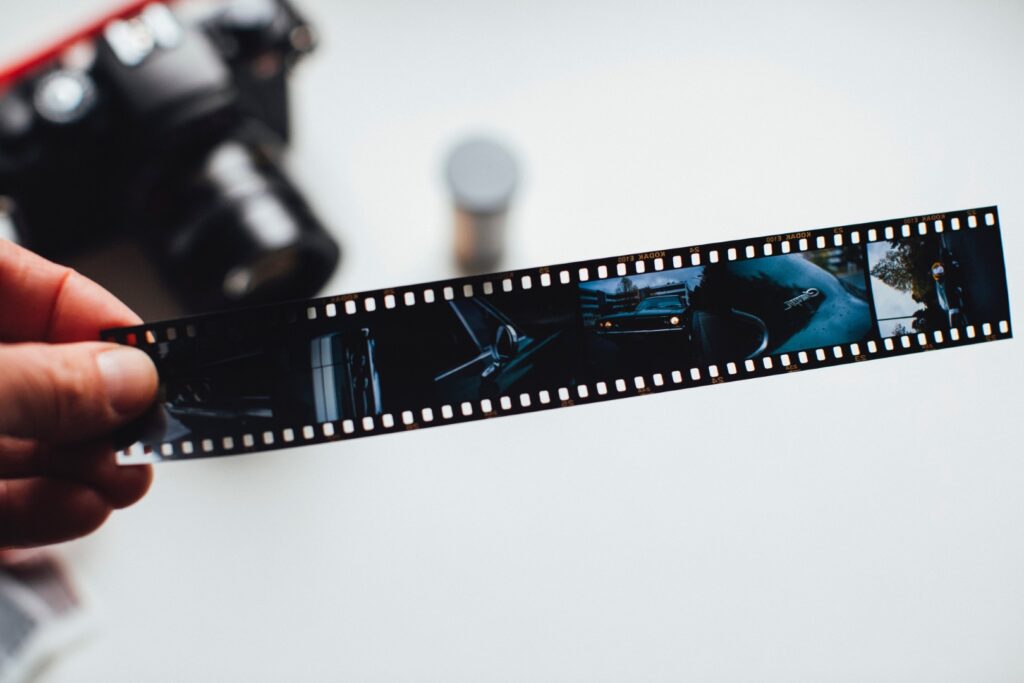
Slide film, also known as reversal or transparency film, produces a positive image directly on the film strip. This means that once developed, the film can be projected onto a screen using a slide projector, hence the name “slide”.
Slide film is renowned for its vibrant colors, fine grain, and high contrast, rendering images that have a distinctly rich and detailed quality. However, Slide film has a narrow exposure latitude compared to Color Negative film, which means accurate exposure is crucial to achieve optimal results.
Choosing between these three types of film stocks depends on the visual aesthetics you wish to achieve, the lighting conditions you’ll be shooting in, and your level of experience in handling film. Each has its charm and characteristics, so don’t be afraid to experiment and find the one that resonates with your style the most.
Considerations When Choosing a Film for Your Olympus OM-1
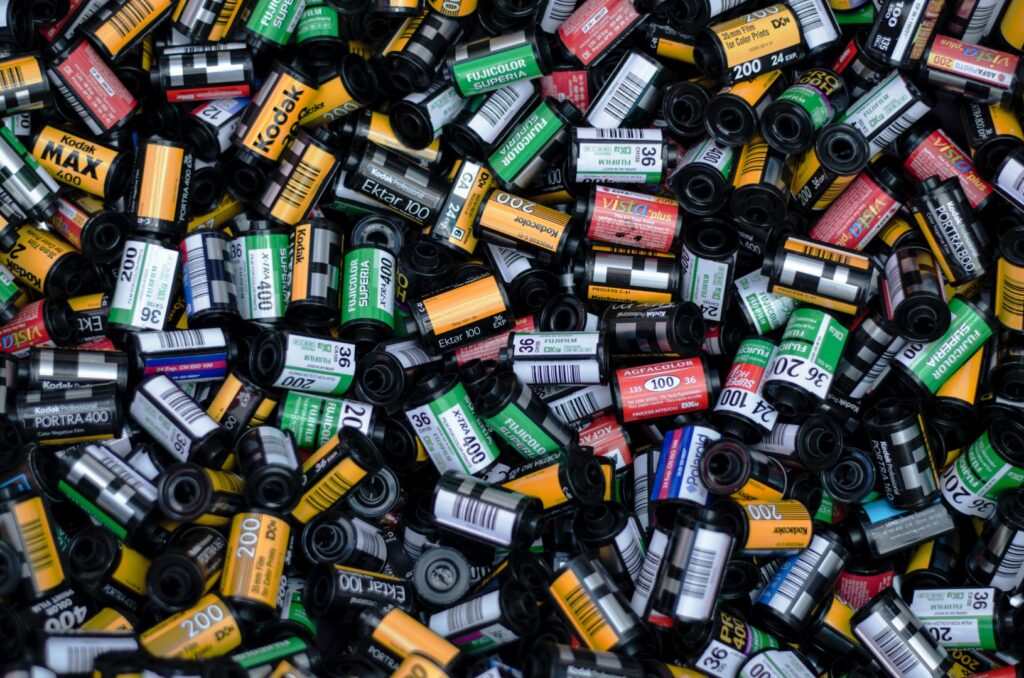
Selecting the right film for your Olympus OM-1 goes beyond simply choosing between black and white, color negative, or slide film. Several other factors come into play that can significantly impact your photographic outcomes. Let’s explore these key considerations.
Film Speed
Film speed, or ISO, plays a pivotal role in film photography. It indicates how sensitive a film is to light, and choosing the appropriate ISO for your shooting conditions is one of the first steps towards capturing great photos.
Low ISO films (like ISO 100 or 200) are less light-sensitive, rendering images with finer grain and better detail, but they require more light for proper exposure. These films are ideal for situations with ample natural light, such as a bright, sunny day, or when you have control over the lighting, such as in a studio setup.
High ISO films (like ISO 800, 1600, or even 3200) are more light-sensitive, making them suitable for low-light conditions like indoor environments, overcast days, or night-time scenes. Keep in mind that these films yield images with more visible grain, which can lend a certain character to your photographs but may not be desirable for all types of images.
For the Olympus OM-1 users, the camera’s manually adjustable ISO range from 25 to 1600 allows you to use a wide variety of films. Here are some quick recommendations:
- ISO 25 to 100: Perfect for bright, sunny days, or well-lit studio environments where you want to capture the finest detail.
- ISO 200 to 400: Suitable for overcast days, early morning, or late afternoon light.
- ISO 800 to 1600: Ideal for indoor photography, dusk/dawn, or night-time scenes.
The Olympus OM-1 also features a built-in light meter to assist you in adjusting your settings to accommodate your chosen film speed. Always consider the lighting conditions, the subject matter, and the aesthetic you wish to achieve when deciding on the film speed for your Olympus OM-1. Experimentation is key to finding what works best for your unique style of photography.
Aesthetic Qualities of the Film Stock
Each film stock has a unique aesthetic characterized by its color rendition, contrast, saturation, and grain structure. Some films produce vibrant, saturated colors, while others render more muted, natural tones. Black and white films vary in their contrast levels and the way they reproduce different shades of gray.
When choosing a film stock, consider the aesthetic you want your photos to have. Do you want your images to be bold and colorful or more subdued and realistic? Or perhaps you prefer the timeless quality of black and white. Experiment with different film stocks to find one that resonates with your creative vision.
Developing and Scanning Film
The process doesn’t end after you’ve shot your roll of film. Developing and scanning are integral parts of the film photography process and can influence how your final images look. Color Negative and Black and White films typically require different development processes (C-41 process for color negative and various methods for black and white). Slide film usually requires E-6 processing, which may not be as readily available.
When it comes to scanning, you have options to do it yourself with a film scanner or have it done at a lab. Scanning at home allows you more control over the final image but requires an initial investment in a scanner and time to scan and process each frame. Keep these considerations in mind when choosing a film, as they can impact not only your shooting process but also the time, cost, and effort involved in bringing your images to life.
Top Film Choices for Olympus OM-1
Choosing the right film can greatly influence the aesthetic of your images. Here, we’ve curated a list of highly-regarded films within each category: color, black and white, and slide films. Each of these films is currently in production and should be available for purchase.
Color Films
Kodak Portra 400: This professional-level film is well-regarded among portrait and wedding photographers for its exceptional skin tone reproduction. Its wide exposure latitude allows for flexibility in various lighting conditions, making it forgiving for beginners while maintaining detail in both shadows and highlights. The resulting images exhibit a warm, natural color palette and a finely detailed grain structure, lending a classic and timeless feel to the photographs. Furthermore, Kodak Portra 400 is versatile and performs well across diverse shooting scenarios, from landscapes to street photography. However, this film is somewhat pricier compared to other color films, which might be a consideration for those on a tight budget. Check current prices here.



Fujifilm Superia X-TRA 400: Superia X-TRA 400 is a favorite amongst many photographers. It provides vibrant, saturated colors and good sharpness, delivering images that have a distinct, cheerful aesthetic. The film is a great all-rounder, performing admirably in a wide range of shooting situations, from daylight to well-lit indoor scenes. While the grain is slightly more noticeable compared to the Kodak Portra 400, this can add a unique texture to your images that some photographers find appealing. Moreover, Superia X-TRA’s high-speed (ISO 400) provides flexibility in varied lighting conditions. Check current prices here.

Kodak Ektar 100: Known for delivering ultra-vivid color and ultra-fine grain, Ektar 100 has often been described as the most color-dense negative film. This makes it an excellent choice for landscape and nature photography, where its saturation and contrast really make the colors pop. The detail and sharpness produced by this film are exceptional, thanks to its finer grain. However, Ektar 100 has a relatively narrow exposure latitude compared to other color negative films. This means that exposure must be more accurate to avoid underexposed or overexposed images. Consequently, while it can deliver stunning results in the right conditions, it may require a bit more skill and attention to detail from the photographer. Check current prices here.

In this selection, we’ve highlighted just a few films that pair excellently with the Olympus OM-1. However, if you’re eager to explore and experiment with a wider range of films, including some more unique or specialty options, be sure to visit our extensive overview on color negative films. It covers all color negative films currently on the market, complete with pricing details and reviews.
Black and White Films
lford HP5 Plus 400: HP5 Plus is a versatile high-speed film with a nominal sensitivity of ISO 400, making it suitable for most shooting scenarios, especially in unpredictable lighting conditions. It produces images with fine grain and excellent sharpness. One of the distinguishing characteristics of this film is its wide exposure latitude. This means that it’s very forgiving of exposure mistakes and is capable of producing good results even when overexposed or underexposed. However, images shot with HP5 Plus tend to have a higher contrast compared to some other films, resulting in more pronounced blacks and whites. This characteristic lends itself to creating images with a dramatic and bold aesthetic, which might be exactly what some photographers are looking for. Check current prices here.



Kodak Tri-X 400: Tri-X 400 is a true classic that has been a choice of many photographers for decades. Known for its distinct aesthetic, it produces images with rich grain structure and high contrast that is synonymous with many black and white photographs of the 20th century. The film is highly flexible and can be pushed or pulled during development to achieve a range of effects and to accommodate different lighting conditions. This allows photographers to control the contrast and grain of their images to some extent. However, the pronounced grain that Tri-X 400 renders can be less appealing for certain types of photography, or for those who prefer a cleaner, less textured image. Check current prices here.

Fujifilm Neopan Acros II 100: Neopan Acros II is a reincarnation of the beloved Neopan Acros, known for its ultra-fine grain, superb sharpness, and excellent detail reproduction. The film’s slower speed (ISO 100) means that it is best suited for situations with plenty of light, or for long exposure photography where the film’s minimal reciprocity failure comes into play. It’s perfect for photographers seeking a high level of detail and a smooth, grainless look in their images. The trade-off, however, is that it’s slightly pricier than HP5 Plus or Tri-X, and less forgiving in low light conditions. Despite this, many photographers find the unique qualities of Neopan Acros II well worth the cost and the care required in shooting. Check current prices here.

In our selection, we’ve only touched on a few films that work wonders with the Olympus OM-1. But for those with a thirst for more, particularly in the realm of black and white photography, our extensive black and white film overview awaits. This comprehensive resource details every black and white film on the market, along with their prices and thoughtful reviews.
Slide Film
Fujifilm Provia 100F: Provia 100F is a professional-quality, daylight-balanced color reversal film well-suited for a wide range of shooting scenarios. It offers exceptionally fine grain, vibrant yet realistic colors, and superb sharpness, making it a preferred choice for landscape photographers and those requiring high color fidelity. It is known for its ability to reproduce a wide gamut of colors with excellent gradation balance. However, slide films such as Provia 100F require more accurate exposure compared to color negative films due to their relatively narrow exposure latitude. This means there’s less room for error when metering your shots. For those who master it, though, the payoff is often an image with outstanding color and detail straight from the scan. Check current prices here.

Fujifilm Velvia 50: Velvia 50 is the choice of many photographers when it comes to capturing richly saturated colors and high contrast scenes. It is renowned for rendering deep, vibrant colors, particularly blues and greens, making it a favorite among landscape and nature photographers. The film’s slower speed (ISO 50) provides very high resolution, super-fine grain, and high sharpness, but it does require plenty of light or a tripod for longer exposures. Just like other slide films, it’s less forgiving when it comes to exposure inaccuracies. Velvia 50’s unique color rendition and contrast might not suit all scenes or tastes, but when used effectively, it can produce truly stunning results. Check current prices here.

Budget-Friendly Film Alternatives
While investing in higher-end films can yield exceptional results, there are plenty of budget-friendly film alternatives that allow you to explore the world of film photography without breaking the bank. Here, we’ll be highlighting three such options – Fomapan 400, Kentmere 100, and Kodak Gold 200.
Fomapan 400 Action: Fomapan 400 is a black and white film that is great for those who are just starting their journey in film photography or those on a tight budget. Despite its affordability, Fomapan 400 offers a unique aesthetic with its grainy appearance and high contrast, lending a vintage and somewhat nostalgic feel to the images. It is quite flexible and forgiving in various lighting conditions due to its higher speed (ISO 400). However, it doesn’t quite match up to the sharpness and fine grain structure offered by some higher-priced films. If you’re after a unique aesthetic and want to experiment with black and white photography without spending a lot, Fomapan 400 is a solid choice. Check current prices here.
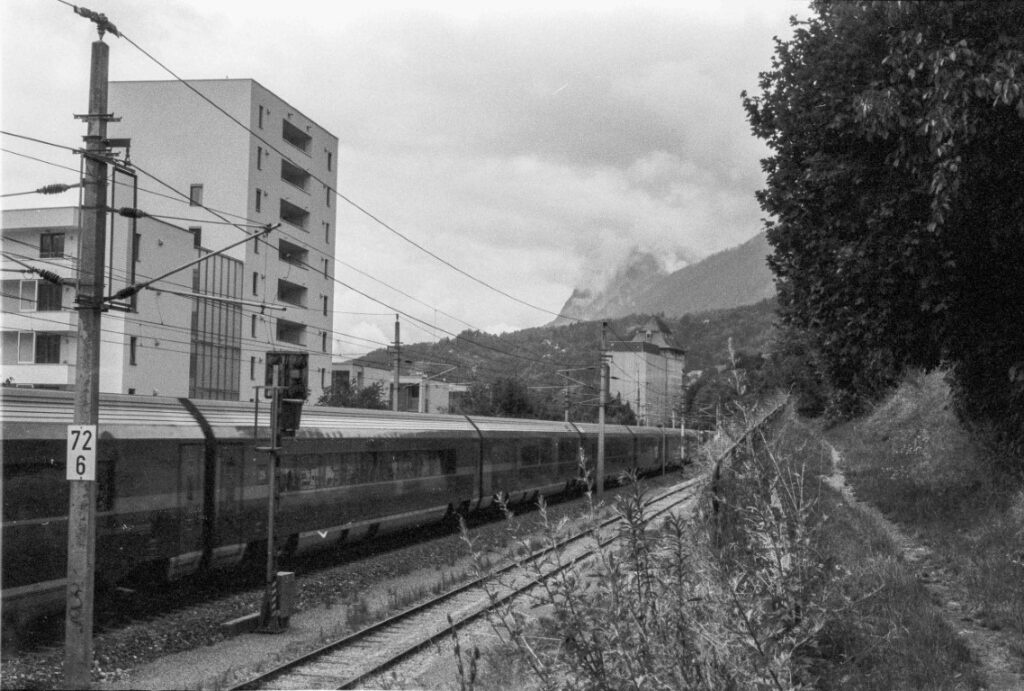
For more Foma 400 images, check out my Fomapan 400 Flickr album. We’ve captured our firsthand experiences with Fomapan 400 in this YouTube video, covering everything from shooting to self-developing the film. Take a look for a comprehensive look.
Kentmere 100: Manufactured by Harmon Technology, the same company behind the esteemed Ilford brand, Kentmere 100 is a budget-friendly black and white film that doesn’t compromise on quality. It offers a fine grain structure and good sharpness for its price point. This slower speed film (ISO 100) requires good lighting conditions, but it can deliver impressively detailed and clear images with a broad tonal range. It’s a great option for those wanting to dip their toes into the world of black and white film photography. Check current prices here.
Kodak Gold 200: As an entry-level color negative film, Kodak Gold 200 offers a lot for its affordable price tag. It provides warm, saturated colors that give a distinct ‘retro’ feel to images. It performs best in bright, outdoor settings due to its ISO 200 speed, delivering sharp images with fine grain. It’s a great option for those starting out with film photography or for anyone looking for a reliable, everyday color film that won’t break the bank. Despite being a budget film, Kodak Gold 200 can yield surprising results, especially when shot in good lighting conditions. Check current prices here.
Frequently Asked Questions about Using Film in Olympus OM-1
Does the Olympus OM-1 work without batteries?
Yes, the Olympus OM-1 can function without a battery. The battery is only required for the light meter. If you’re comfortable with estimating exposure or using an external light meter, you can shoot with the OM-1 without a battery. If you are interested to learn more about the OM-1 and its batteries, check our in depth guide.
Is Olympus OM-1 a professional camera?
The Olympus OM-1, introduced in 1972, was designed to be a professional-grade camera packed into a more compact, user-friendly body. It was highly praised for its robustness, mechanical reliability, and exceptional optics, and was widely used by both professionals and serious amateurs.
How old is the OM-1?
The Olympus OM-1 was first introduced to the market in 1972. It was part of the Olympus OM system, a line of 35mm film cameras, lenses and accessories.
Is the Olympus OM-1 fully mechanical?
Yes, the Olympus OM-1 is a fully mechanical camera. This means that it does not rely on electronics to control its main functions like shutter speed and aperture, which can be manually adjusted. The only electronic component is the light meter, which requires a battery to operate.
What film speed does the Olympus OM-1 support?
The Olympus OM-1’s light meter supports a range of film speeds from ISO 25 to ISO 1600. However, you can use films outside this range by manually adjusting your exposure settings.
How is the image quality when using film with Olympus OM-1?
The image quality you get when using film with the Olympus OM-1 will largely depend on your choice of lens, film, and exposure settings. The OM-1 was part of a system that included a range of high-quality lenses, so with a good lens and the right film, you can achieve excellent results.
Can Olympus OM-1 support both manual and automatic film loading?
The Olympus OM-1 uses a manual film loading system. After inserting the film cartridge in the camera, you manually thread the film leader onto the take-up spool and advance the film to the first frame.

